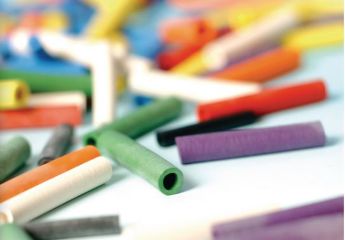
Each application has its own requirements for an insulating tube. That's why there are insulating sleevings in a wide variety of materials. For instance, in addition to neoprene sleeves and silicone tubings, there are also PTFE tubings and PVC tubes.
Apart from the material properties, many other factors also play an important role, such as wall thickness, colour or length of the insulation material.
Next to insulating tubing and grommets in all variations, HellermannTyton also offers suitable tools and lubricants for easier assembly.

Chloroprene sleeves (other term for neoprene) are used for insulation and protection against mechanical stress in many areas of wire technology or electronic component production.
Thanks to their high expansion factor of up to 500 %, neoprene sleeves cover many cable diameters with one size.
Standard wall chloroprene tubes:
Thin wall chloroprene tubes:
Whether blue, yellow or black, thin or thick walled: Neoprene tubing is available in different colours, quantities and material thicknesses.
The halogen free silicone rubber tubing Helsyn SLP with its good insulating properties is particularly suitable for sensitive equipment, for example, in the aerospace or rail industries.
These and our other sleeves are available in international resistor colour code or transparent. In addition, HellermannTyton silicone tubes come in a wide range of lengths and wall thicknesses.
Silicone tubing features and advantages:

The FE insulation tubing range is manufactured from a high grade extruded PTFE. It is perfectly suited for demanding industrial applications with high temperatures and/or aggressive chemicals.
In addition to the often used natural variant, FE series tubing is also available in red or brown. FE PTFE sleeving is also available in many other versions.
PTFE tubing features and advantages:

PVC tubing from HellermannTyton is found in many areas. Thanks to the variety of colours, this tubing is often used in the field of industrial identification.
A remarkable quality feature: We coextrude our green-yellow PVC hose in two colours. That means the colours are not just printed, but permanent. This makes it especially durable and reliable.
PVC tubing features and advantages:

A useful tool for easily applying sleeves and grommets on all types of cables and connectors is the NA series sleeve expander tool.
This is how you use the special pliers:
1. Simply slide the sleeve onto the 3 prongs
2. Squeeze the pliers to expand the sleeve
3. Slip the sleeve over the cable or conductor and release
To make installation even easier, we recommend the use of Hellerine lubricant.
For higher loads the VA2.5/5 three-pronged Expansion Tool made of stainless steel is recommended. Replacement pins are available for both these and the NA-series three-pronged pliers to accommodate a wide range of diameters.

To simplify the installation of insulating sleeves and grommets, we recommend specially formulated Hellerine lubricant.
Containing 99% plant-based oil Hellerine is used to lubricate the sleeves during assembly. The fluid evaporates free of residue shortly after use.
Hellerine sleeve and grommet lubricant does not discolour and is available in different sizes:
Insulating tubes prevent electrical current from passing through or between conductive components protecting cables from short circuiting. Insulating tubes play a critical role in ensuring the safety, efficiency, and reliability of systems and components across various sectors, including construction, automotive, aerospace, electronics, and more.
One product group within insulating tubes is heat shrink tubing. Heat shrink tubing has the unique property of shrinking when exposed to heat, which allows it to conform tightly to the components it covers.
Silicone insulating tubes, also known as silicone insulation sleeves or silicone tubing, are cylindrical or tubular materials made from silicone rubber. These tubes are used for a wide range of applications where electrical, thermal, or environmental insulation is required, and where the unique properties of silicone are advantageous.
The key advantage of transparency lies in the ability to visually inspect the contents or condition of the tubing without the need for disassembly.
Neoprene tubing, which is made from a type of synthetic rubber called neoprene, offers several benefits in various applications. Advantages besides insulation and mechanical protection are:
Lubricants are often used in conjunction with insulating tubes, especially in applications where the tubing needs to be installed or pulled through a conduit or over a cable. The lubricant reduces friction when sliding the tube into place. After a short amount of time, the lubricant disintegrates so the tubing does not slide around but stays where it needs to be. When using lubricant with neoprene tubing, the lubricant is absorbed back into the neoprene preventing the material from becoming hard and brittle.